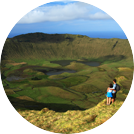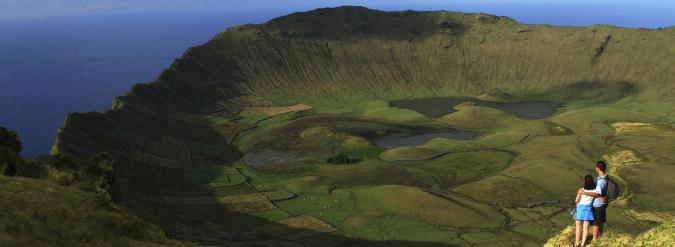Corvo

Corvo is the smallest of the islands, with only 400 inhabitants and 17 km2 of land. With much of the island occupied by a single extinct volcano with a 300-metre deep crater, Corvo has a remarkable landscape. The monumental caldera is surrounded by lush hillsides filled with hydrangeas that fall steeply to the sea, while the interior features two lakes from which several small islets emerge.
There is only one town on the island, the small Vila do Corvo, a picturesque town with whitewashed houses and streets cobbled with pebbles. In the oldest part of the town these streets form a maze of narrow passages designed to shelter it from the strong winds of winter.
Corvo is fast gaining a reputation for bird watching. You can spot several migratory birds from North America which look for food in this little spot in the middle of the ocean while resting from their long journey. Large seabirds are also regularly spotted.
Along with Flores, the relative isolation and small size of the island means that marine life thrives here. it was the first and only island to set up a voluntary reserve, thanks to which it is now possible to dive a few centimetres away from several large dusky groupers, some over 30 kilograms. Although the Dusky Grouper Passageway is a unique place for diving, Corvo offers several other great sites such as Moldinho or Pedras do Atlas, Gamela (just outside the Vila do Corvo Harbour), and the Buraco Reef, among many others. Here it is common to find schools of yellowmouth barracudas, Almaco jacks, white trevallies, parrotfishes, barred hogfishes, island groupers, and blacktail combers along the seafloor, as well as many other typical species of the Azores.


